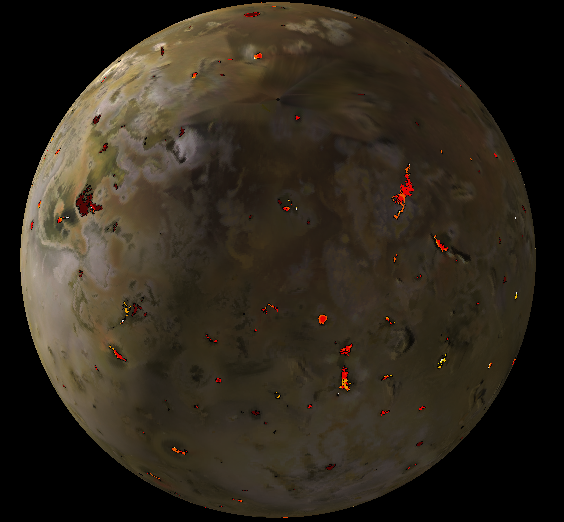- 1LPL/University of Arizona, Planetary Sciences, Tucson, United States of America (mcewen@pirl.lpl.arizona.edu)
- 2U.S. Geological Survey, Flagstaff AZ, USA
- 3JHU Applied Physics Laboratory, Laurel MD, USA
- 4Jet Propulsion Laboratory, Pasadena CA, USA
- 5University of California Los Angeles, CA, USA
- 6University of Bern, Bern, CH
- 7German Aerospace Center (DLR), Berlin, DE
Io, the world with the greatest tidal flexing, volcanic and tectonic activity, and mass-loss in our solar system, begs for dedicated exploration. Missions such as Juno and JUICE, along with Earth-based telescopes such as JWST and ALMA, will acquire important Io observations over the next 15 years, as could Europa Clipper. However, a mission designed for Io science is necessary to accomplish key science goals that have been consistently prioritized in the National Academy of Sciences Decadal Surveys and the ESA Voyage 2050 (Thomas, 2021, Experimental Astronomy online), including understanding the early evolution of terrestrial planets, tidally heated exoplanets and ocean worlds, and magnetospheric physics across the galaxy. The NASA Discovery-class Io Volcano Observer (IVO; McEwen et al., 2021, LPSC 1352) completed Phase A in 2021 and was deemed selectable, but was not chosen for programmatic (i.e., non-science/engineering) reasons. The IVO concept study demonstrated how a total of ten carefully designed, close Io flybys could determine the melt distribution in Io’s interior to confirm or refute the presence of a magma ocean, constrain Io’s global average lithospheric structure, identify where and how Io is losing heat, and determine processes and rates for Io’s volatile loss. Such encounters would also measure Io’s rate of orbital migration, key to determining the stability of the LaPlace resonance that heats Europa and Ganymede, as well as Io. The ambitious (for Discovery) science payload included a magnetometer, plasma instrument, narrow-angle camera, thermal mapper, neutral mass spectrometer, plus a telecom system for gravity science and options for a student-collaboration wide-angle camera (WAC), and a technology demonstration UV spectrometer.
The next Discovery mission proposal opportunity is expected in 2025 or later, but an opportunity to propose an Io mission in NASA’s New Frontiers (NF) program is anticipated in 2023. How might that differ from a Discovery-class mission? An Io orbiter to provide better geophysical measurements has been suggested in the past, but would be very challenging deep inside Jupiter’s gravity well and high radiation zone. An orbiter might be feasible if new, more capable launch vehicles become available. On the other hand, the IVO Discovery concept would accomplish all of the science objectives of NF, and could be augmented in several key ways using the additional resources available in NF. A radiation design to support more than 10 encounters is a relatively straightforward enhancement. Ka-band would improve the data downlink capability and gravity science. With twice as many Io encounters, it would be possible to more completely map Io’s surface at multiple wavelengths; encounter Io over additional values of orbital true anomaly for improved gravity science, magnetic induction, and measuring Io’s libration; and sample more longitudes and times of day to understand Io’s atmosphere, plumes, magnetospheric interactions, and mass loss. The WAC, which is especially important for mapping Io’s topography, could be a required Baseline experiment. There are many science instruments that would be valuable additions, including altimetry, ultraviolet and near-IR spectroscopy, a dust mass spectrometer, passive radar sounding (using Jupiter radiation), active radar sounding, and additional fields and particle instruments. Greater emphasis may be placed on tracing the mass and energy flows in the Io-Jupiter system, especially because the new US Planetary Science and Astrobiology Decadal Survey places much emphasis on understanding planetary systems relevant to exoplanets. Interferometric synthetic aperture radar (InSAR) would be challenging but could transform our understanding of active processes on Io. An even more daring idea is to deliver a penetrator that could measure Io’s seismicity and conducted heat flow, perhaps also with a laser retroreflector or radio transponder to measure Io’s rotational and tidal deformation. However, getting substantial data back to the main spacecraft for transmittal to Earth is challenging in the very fast flybys that are preferred to keep the total ionizing radiation dose low. In terms of international collaboration, we expect a thermal mapper from DLR and a neutral mass spectrometer from UBE, plus science co-investigators; additional contributions are possible. In summary, a highly capable mission to one of the most exciting objects in the Solar System is overdue.
Figure: Io is a spectacular target to observe both in daytime and at night (simulated hot spots).

How to cite: McEwen, A., Carter, L., DellaGiustina, D., Kestay, L., Denevi, B., Haapala, A., Westlake, J., Park, R., Khurana, K., Thomas, N., Wurz, P., and Helbert, J.: A NASA New Frontiers Mission Concept to Io, Europlanet Science Congress 2022, Granada, Spain, 18–23 Sep 2022, EPSC2022-37, https://doi.org/10.5194/epsc2022-37, 2022.

